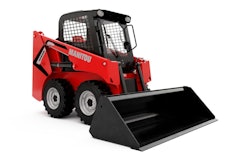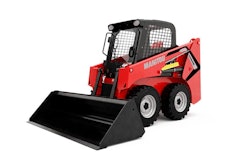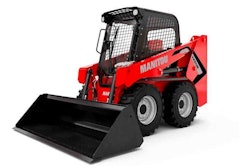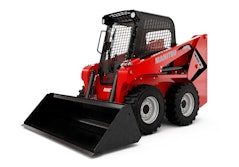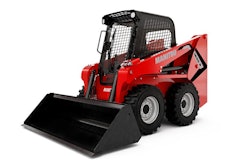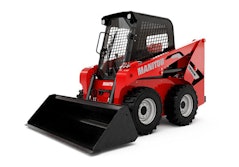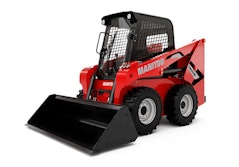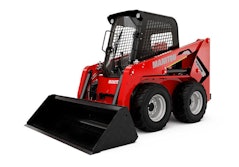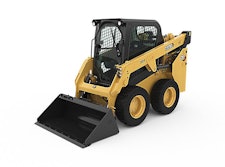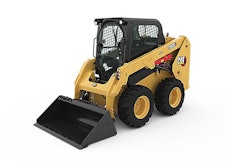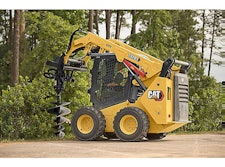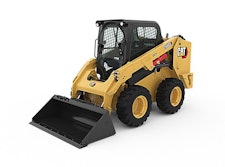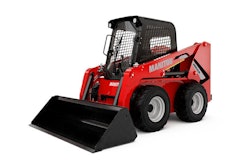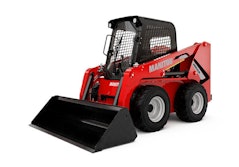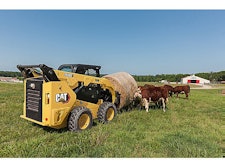Skid Steer Loaders
A skid-steer loader, also known as a skid loader or skid steer, is a small, compact, four-wheeled, or tracked vehicle with a rigid frame and a powerful engine. It is designed to perform various tasks in construction, agriculture, landscaping, and other industries.
A skid-steer loader, also known as a skid loader or skid steer, is a small, compact, four-wheeled, or tracked vehicle with a rigid frame and a powerful engine. It is designed to perform various tasks in construction, agriculture, landscaping, and other industries.
One of the defining features of a skid-steer loader is its ability to turn on the spot, or "skid," in place by independently driving each wheel or track in opposite directions. It allows the machine to maneuver easily in tight spaces and turn quickly without needing a large turning radius.
Skid-steer loaders typically have a small cab or open operator station at the front of the machine, with the engine behind it. The operator sits in the cab and controls the machine using two hand-operated joysticks, one for each side of the machine. These joysticks control the speed and direction of the wheels or tracks and any attachments being used, such as a bucket, pallet forks, or a brush cutter.
Skid-steer loaders are versatile machines used for various tasks, including digging, hauling, grading, lifting, and demolition. They are often used in construction sites, landscaping projects, and agricultural operations, as well as for snow removal and other maintenance tasks.
While skid steer loaders and compact track loaders share some similarities, they are not the same thing.
A skid steer loader has four wheels and tires, while a compact track loader (CTL) has tracks instead of wheels. The tracks on a CTL provide more traction and stability on rough or uneven terrain and better flotation on the soft or muddy ground. It makes them ideal for construction, landscaping, and agricultural applications where mobility over varied terrain is essential.
Another difference between skid steer loaders and CTLs is their weight distribution. Because of the tracks, CTLs are heavier than skid steer loaders, which can make them more stable and less prone to tipping over. However, the increased weight can make them less maneuverable in some situations.
Finally, the hydraulic system on a CTL is typically more advanced than that on a skid steer loader, with higher pressure and more advanced controls. With greater efficiency and precision, this allows them to operate more powerful attachments, such as mulchers, stump grinders, and augers.
Overall, while there are some similarities between skid steer loaders and compact track loaders, the differences in their design and capabilities make them better suited for different applications and operating conditions.
Whether to buy a skid steer or a compact track loader depends on your specific needs and the conditions in which you will be operating the machine.
Skid steer loaders are generally better suited for hard, flat surfaces, such as concrete or asphalt, where their maneuverability and speed can be maximized. They are also generally less expensive than compact track loaders.
On the other hand, if you are operating in soft, muddy, or uneven terrain, a compact track loader may be a better choice. The compact track loader (CTL) tracks provide better traction and flotation, making them more stable and less likely to get stuck in such conditions. Additionally, the increased weight of the CTL can make it a better choice for heavy-duty tasks that require more excellent lifting or pushing power.
Another factor to consider is the cost of ownership. CTLs tend to have higher upfront costs than skid steer loaders, but they can also have lower ongoing maintenance and repair costs due to their more durable tracks and higher ground clearance.
Buying a skid steer or a compact track loader depends on your needs and operating conditions. It's a good idea to research, talk to equipment dealers, and perhaps even rent or demo both types of machines before making a final decision.
Whether or not you should buy a compact wheel loader instead of a skid steer or compact track loader depends on your specific needs and the conditions in which you will be operating the machine.
Compact wheel loaders are similar to skid steer and compact track loaders in that they are versatile machines you can use for various tasks. However, they have some key differences.
One of the main advantages of a compact wheel loader is its stability. Unlike skid steer and compact track loaders, which can be prone to tipping over if the load is not balanced correctly, compact wheel loaders have a wider stance and a lower center of gravity, which makes them more stable and less likely to tip over.
Compact wheel loaders are generally better suited for hard surfaces, such as concrete or pavement, than compact track loaders. You can also use them for light snow removal, which is not recommended for skid steer or compact track loaders.
However, compact wheel loaders may not be as maneuverable as a skid steer or compact track loaders and may not be as effective in soft or muddy terrain.
Ultimately, whether or not you should buy a compact wheel loader instead of a skid steer or compact track loader depends on your specific needs and the conditions in which you will be operating the machine. It's a good idea to research, talk to equipment dealers, and perhaps even rent or demo all three types of machines before making a final decision.
There are several reasons why you might want to consider buying a skid steer loader for your business or personal use:
1- Versatility:
Skid steer loaders are highly versatile machines that you can use for various tasks, including digging, hauling, grading, lifting, and demolition. They can also be used with various attachments, such as buckets, pallet forks, and brush cutters, making them highly adaptable to different applications.
2- Maneuverability:
Skid steer loaders are designed to turn on the spot, or "skid," in place, making them highly maneuverable in tight spaces and crowded job sites. It lets you do work quickly and efficiently, even in small or confined areas.
3- Speed:
Skid steer loaders are generally faster than other loaders, such as compact wheel loaders or backhoes, which can help you complete more work in less time.
4- Affordability:
Skid steer loaders are generally less expensive than other loaders, making them a more affordable option for small businesses or individuals.
5- Easy to operate:
Skid steer loaders are relatively easy to operate, with simple controls that most people can quickly master. It can help reduce training costs and minimize the learning curve for new operators.
Renting a skid steer can be a good option for several reasons:
1- Flexibility:
Renting a skid steer gives you the flexibility to have the equipment when you need it without a long-term investment commitment. Depending on your specific needs, you can rent a skid steer for a day, a week, or even longer.
2- Cost savings:
Renting a skid steer can be a cost-effective alternative to buying a machine, especially if you only need it occasionally for a short-term project. Renting also eliminates the need for maintenance, repairs, and storage costs.
3- Try before you buy:
Renting a skid steer can allow you to try different models and brands before purchasing. It can help you determine essential features and specifications and make a more informed buying decision.
4- Access to newer equipment:
When renting a skid steer, you can typically choose from a range of newer, well-maintained equipment options. It can give you access to the latest technology and features without the expense of buying a brand-new machine.
5- Expert advice:
Rental companies often have experienced staff who can provide expert advice and guidance on selecting the right skid steer for your needs. They can also offer training on operating the equipment safely and effectively.
Renting a skid steer can be a good option for flexibility, cost savings, or access to newer equipment. It's a good idea to compare rental options and prices and to carefully consider your specific needs and budget before deciding.
Dual-lever foot control is used on skid steer loaders to operate the machine's various functions, such as the loader arms, bucket, and other attachments. The system is called a "dual lever" because it uses two-foot pedals, one for each side of the machine, to control the direction and speed of the wheels or tracks.
The dual-lever foot control system is commonly used on older model skid steer loaders and is still available on some newer models as an option. With this system, the operator uses their feet to control the machine's movement and the position of the loader arms, allowing them to perform multiple functions simultaneously.
The left pedal controls the left side of the machine's hydraulic system, while the right pedal controls the right side. To move the machine forward or backward, the operator pushes both pedals forward or backward at the same time. To turn, they press one pedal forward and the other backward. To raise or lower the loader arms, the operator pushes the pedal forward or backward while holding the other pedal steady.
While dual-lever foot control can be an effective way to operate a skid steer loader, it can also take some time to get used to and may require more effort from the operator than newer control systems, such as a joystick or hand lever controls. Choosing the control system that best suits your needs and preferences as an operator is essential.
H-pattern control is a system used on skid steer loaders to operate the machine's various functions, such as the loader arms, bucket, and other attachments. The H-pattern control system uses two hand levers to control the direction and speed of the wheels or tracks and the position of the loader arms and other hydraulic attachments.
The H-pattern control system is so named because the two hand levers are arranged as an "H." The left-hand lever controls the left-side hydraulic system, while the right-hand lever controls the right-side hydraulic system. To move the machine forward or backward, the operator pushes both levers forward or backward at the same time. To turn, they push one lever forward and pull the other back. To raise or lower the loader arms, the operator moves the respective lever forward or backward while holding the other lever steady.
The H-pattern control system is commonly used on newer skid steer loaders and is often preferred by operators who are used to operating equipment with hand levers, such as backhoes or excavators. Some operators also prefer the H-pattern control system because it allows them to keep their feet free to operate other pedals, such as the throttle or brake.
The choice between H-pattern control and other control systems, such as dual-lever foot control or a joystick control, depends on the operator's preferences and experience, as well as the specific requirements of the job at hand.
ISO joystick control is a system used on skid steer loaders to operate the machine's various functions, such as the loader arms, bucket, and other attachments. The ISO joystick control system uses two joysticks, one for each hand, to control the direction and speed of the wheels or tracks and the position of the loader arms and other hydraulic attachments.
The ISO joystick control system is so named because it conforms to the International Organization for Standardization (ISO) standards for joystick control. The left-hand joystick controls the machine's movement, with forward and backward movement controlling the machine's speed and left and proper movement controlling the machine's direction. The right-hand joystick controls the loader arms and other hydraulic attachments, with forward and backward movement controlling the arm's position and left and proper movement controlling the attachment's rotation.
The ISO joystick control system is becoming increasingly popular on newer skid steer loaders, as it offers a more intuitive and ergonomic control system compared to other options, such as dual-lever foot control or H-pattern control. The system is designed to be easy to learn and operate, allowing operators to perform multiple functions simultaneously with precision and control.
Selectable joystick controls are used on skid steer loaders to operate the machine's various functions, such as the loader arms, bucket, and other attachments. As the name suggests, selectable joystick controls allow the operator to choose between different control modes or settings for the joysticks, depending on their preference or the requirements of the job at hand.
Selectable joystick controls typically offer several different control modes, including ISO joystick control, H-pattern control, or dual-lever foot control. The operator can choose which control mode they prefer or switch between modes as needed.
The advantage of selectable joystick controls is that they offer greater flexibility and versatility compared to fixed control systems. For example, an operator used to operating equipment with hand levers may prefer to switch to H-pattern control if they are working on a job requiring greater precision or control. Similarly, an operator used to operating equipment with foot controls may prefer to switch to dual-lever foot control if they find it more comfortable or efficient.
There are two main types of control patterns for skid steers: the "ISO" pattern and the "H-Pattern" (also known as the "New Holland" pattern). The ISO pattern is the most common, where the left joystick controls the drive functions, and the right joystick controls the loader functions. The H-Pattern is less common, where the left joystick controls the left-side drive and loader functions, while the right joystick controls the right-side drive and loader functions.
Most operators find the ISO pattern more intuitive and easier to learn. It also allows for more precise control of the loader functions, making it ideal for tasks requiring high accuracy. The H-pattern is less common, but some operators prefer it for certain types of work, such as when they need to control both drive and loader functions simultaneously on one side of the machine.
Ultimately, the choice of control pattern will depend on your preference and the type of work you will do with the machine. Try out both patterns and determine which one feels more comfortable and natural to you before deciding.
Electrohydraulic controls are a type of control system that uses a combination of electrical and hydraulic components to regulate the operation of machinery and equipment. In these systems, an electrical signal activates a hydraulic component, such as a valve, pump, or motor, which controls fluid flow. It allows for precise control over the operation of machinery and equipment.
Electrohydraulic controls are commonly used in various applications, including industrial machinery, construction equipment, aerospace systems, and marine vessels. They are often used when high force or precision is required, such as in hydraulic presses, cranes, or robotic arms.
Electrohydraulic controls offer several advantages, including high precision, reliability, and flexibility in controlling machinery and equipment. They also provide the ability to remotely control machinery, which can increase safety and efficiency in a wide range of applications.
Whether or not to spec your skid steer with electrohydraulic controls depends on your specific needs and the tasks you will perform with the machine.
Electrohydraulic controls offer several benefits over traditional hydraulic controls. They allow for more precise control over the machine's functions, increasing productivity and reducing operator fatigue. They also offer the ability to program specific functions and settings, which can further improve efficiency and consistency.
However, electrohydraulic controls can be more complex and expensive than traditional ones. They require additional electrical components and may require specialized training for operators to use effectively.
Suppose you will be performing tasks requiring high precision or strict performance requirements, such as in the construction, agriculture, or mining industries. In that case, electrohydraulic controls may be a good choice. However, traditional hydraulic controls may be sufficient if you perform more straightforward tasks or have a limited budget.
The decision to spec your skid steer with electrohydraulic controls should be based on carefully considering your specific needs and the benefits and drawbacks of each control system.
Load-sensing hydraulics is a type of hydraulic system that uses a pressure-compensated pump to sense the load on the system and adjust the flow of hydraulic fluid accordingly. It allows the system to provide only the required amount of hydraulic power to perform a specific task, reducing energy consumption and increasing efficiency.
In a load-sensing hydraulic system, a pressure-compensated pump provides hydraulic power. The pump is designed to adjust the flow of hydraulic fluid based on the load sensed by the system, ensuring that the power provided is only needed to perform the task.
Load-sensing hydraulics are commonly used in heavy machineries, such as excavators, cranes, and bulldozers, where precise control over hydraulic power is essential. They allow for more efficient operation of the machinery and can help reduce energy consumption, leading to lower operating costs and environmental benefits.
Load-sensing hydraulics is a highly efficient and effective technology for controlling hydraulic power. It offers precise control over hydraulic functions, reduces energy consumption, and increases the lifespan of hydraulic components, making them an attractive option for a wide range of hydraulic applications.
High-flow hydraulics are designed to deliver a higher volume of hydraulic fluid to the equipment's hydraulic motors, allowing for increased speed and power. It can be helpful for tasks that require high levels of productivity, such as clearing large areas of land, or for using specialized hydraulic attachments, such as hydraulic hammers or augers.
However, high-flow hydraulics can also increase the cost and complexity of the equipment, as well as the amount of energy needed to power the hydraulic system. It can make it less efficient and more expensive, mainly if you do not require the increased power and speed they provide.
If you are performing tasks that require high levels of productivity or specialized attachments, high-flow hydraulics may be a good choice. However, if you will be performing more straightforward tasks or do not require the increased power and speed provided by high-flow hydraulics, then a standard hydraulic system may be sufficient and more cost-effective.
The main difference between vertical and radial lift arms on a skid steer is how they move the loader arms and bucket when lifting and dumping material.
Vertical lift arms move the loader arms and bucket in a straight up-and-down motion. It allows the machine to lift material higher and easily reach over obstacles. Vertical lift arms are ideal for loading material into trucks, stacking material, and working in tight spaces.
Radial lift arms, on the other hand, move the loader arms and bucket in an arc-shaped path, which means the bucket moves forward as it lifts. It allows the machine to reach out and dump material further away from the machine, making it ideal for grading, digging, and backfilling tasks. Radial lift arms also provide better visibility to the operator and are generally more stable when working on uneven terrain.
The choice between vertical and radial lift arms depends on your specific tasks with the machine. If you are performing tasks that require high lifting heights or working in tight spaces, then vertical lift arms may be the better choice. If you are performing tasks requiring reaching out and dumping material further away from the machine, or working on uneven terrain, radial lift arms may be the better choice.
The choice between vertical and radial lift arms for a loader will depend on your project. Both types of lift arms have their advantages and disadvantages.
Vertical lift arms are better suited for applications that require high lift capacity and reach, such as loading material onto trucks or stacking materials in a warehouse. They are typically better for tasks requiring vertical lifting or dumping, as they provide greater height and reach.
Radial lift arms, on the other hand, are better suited for tasks that require more horizontal movement, such as digging and excavating. They offer more digging depth and reach than vertical lift arms, making them better for digging foundations or trenching.
Ultimately, the decision between vertical and radial lift arms will depend on the specific needs of your project. Vertical lift arms may be the better choice if you need high lift capacity and reach. If you need more horizontal movement and digging ability, radial lift arms may be the better choice. It's always a good idea to consult a professional contractor or equipment rental company to determine which type of lift arm is best for your project.
Yes, a skid steer can be a good tool for grading, particularly for small to medium-sized projects. Skid steers are versatile machines commonly used in construction and landscaping applications, including grading. They can be equipped with various attachments, such as a grading blade or a land leveler, to effectively grade and level surfaces.
Skid steers are particularly useful for grading projects that require precision and maneuverability in tight spaces, such as around buildings or other structures. They can also help grade uneven terrain or slopes, as they have good traction and can easily navigate rugged terrain.
However, it's important to note that the effectiveness of a skid steer for grading will depend on various factors, including the operator's skill and experience, the equipment's quality, and the project's nature. It's always a good idea to consult a professional contractor or equipment rental company to determine if a skid steer is the best option for your grading project.
The most significant factors in skid steer visibility are:
1- Operator Positioning:
The operator's position within the cab is crucial in skid steer visibility. Operators should be positioned in a way that provides them with the best possible view of the work area. It includes adjusting the seat, armrests, and controls to optimize visibility.
2- Cab Design:
The design of the cab can impact visibility. A well-designed cab will have large windows that provide a clear view of the work area and the surroundings. Cab layout, door design, and the placement of mirrors are also important considerations.
3- Lighting:
Good lighting is essential for visibility when operating a skid steer. Properly placed and bright work lights can improve visibility in low-light conditions or indoors.
4- Attachment Size:
The attachment size used on the skid steer can also impact visibility. Larger attachments can obstruct the operator's view, making it more challenging to see the work area.
5- Environmental Conditions:
The weather and environmental conditions can also affect visibility. For example, fog, rain, or dust can reduce visibility and make it more challenging to operate a skid steer. Considering these factors and adjusting the skid steer's operation is essential.
Skid steer loaders are powerful machines used in various applications, but they can also be tiring to operate for extended periods. To help reduce operator fatigue and increase productivity, manufacturers have developed a range of comfort features for skid steer loaders. Here are some of the most common ones:
1- Comfortable seating:
Look for skid steer loaders with adjustable seats and armrests that support the back and arms. Some seats also have a suspension system to reduce the impact of bumps and vibrations.
2- Climate control:
Many skid steer loaders have a heating and air conditioning system to keep the operator comfortable in extreme weather conditions.
3- Low noise and vibration:
Skid steer loaders can be noisy and generate a lot of vibration, which can fatigue over time. Look for machines that are designed to reduce noise and vibration levels.
4- Easy-to-use controls:
The operator's controls should be intuitive and easy to use. They should be ergonomically designed to reduce strain on the operator's wrists and fingers.
5- Visibility:
Good visibility is essential for the safe operation of a skid steer loader. Ensure the machine has large windows and a clear view of the work area.
6- Lighting:
Skid steer loaders are often used in low-light conditions, so having adequate lighting is essential. Look for machines with high-quality headlights and work lights.
7- Telematics:
Some skid steer loaders come with telematics systems that can track the machine's location, hours of operation, and maintenance needs. It can help you keep your machine in top condition and prevent breakdowns.
In addition to comfort features, there are a variety of other upgrades and options that you may want to consider when selecting a skid steer loader. Here are some of the most common ones:
1- High-flow hydraulics:
Skid steer loaders with high-flow hydraulics can handle more demanding attachments such as cold planers, mulchers, and hydraulic hammers.
2- Auxiliary hydraulic lines:
If you plan to use a variety of attachments, look for a skid steer loader with multiple auxiliary hydraulic lines. It will allow you to easily switch between attachments without disconnecting and reconnecting hydraulic lines.
3- Tracks:
While most skid steer loaders come with wheels, some models offer tracks instead. Tracked skid steer loaders provide better traction and stability on soft or uneven terrain.
4- Cab protection:
If you work in a hazardous environment, you may want to consider a skid steer loader with cab protection, such as a reinforced roof, side screens, or a full cab enclosure.
5- Backup cameras:
Some skid steer loaders come with backup cameras, which can help the operator see behind the machine and avoid collisions.
6- Self-leveling:
Skid steer loaders with self-leveling systems can automatically maintain a level bucket or attachment position, saving time and reducing operator fatigue.
7- Ride control:
Skid steer loaders with ride control systems can reduce machine bounce and improve operator comfort when traveling over rough terrain.
8- High-performance engines:
Upgraded engines can increase horsepower and torque, allowing the skid steer loader to handle more demanding tasks.
When selecting a skid steer loader, consider which upgrades will benefit your application and budget.
Whether or not you need a remote control for your skid steer depends on the specific use case and the operator's preference. Here are some factors to consider:
1- Safety:
If you are working in a hazardous environment or with dangerous materials, remote control can allow the operator to control the machine from a safe distance.
2- Productivity:
Remote control can increase the operator's productivity by allowing them to control the machine more comfortably or by enabling them to operate multiple machines simultaneously.
3- Cost:
Remote control systems can add a high cost to a skid steer loader, so weighing the benefits against the expense is essential.
4- Complexity:
Remote control systems can add complexity to the operation of a skid steer loader, which can be challenging for some operators to learn and use effectively.
5- Application:
The remote control may be more necessary for specific applications, such as demolition work or hazardous waste removal, where the operator must stay safe from the machine.
Overall, the remote control is not essential for most skid steer applications. However, a remote control system may be worth considering if safety is a concern or if it can increase productivity.
It would be best to care about ECO mode as it can help you save fuel and reduce operating costs. Here's how it works:
ECO mode is a feature found on many modern skids steer loaders that help to optimize fuel consumption by adjusting the machine's engine speed and power output. When ECO mode is activated, the engine runs at a lower RPM, which reduces fuel consumption and engine wear.
In addition to saving fuel, the ECO mode can also reduce emissions, which is becoming increasingly important as environmental regulations become stricter. Some manufacturers claim that ECO mode can reduce fuel consumption by up to 30% compared to regular operation.
However, it's important to note that ECO mode may not be suitable for all applications. In some cases, such as when operating with heavy loads, you may need the engine's full power to get the job done. Operating in ECO mode could reduce productivity and increase cycle times in these cases.
Therefore, you should consider your application and operating conditions carefully before using ECO mode. But overall, ECO mode is a valuable feature that can help you save fuel, reduce emissions, and lower operating costs, making it worth considering.
